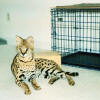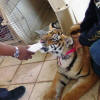This wolf cub is enjoying his dog crate where he feels safe. Plastic crates and wire cages made for domestic dogs and cats come in many colors, sizes and wire strength. They are perfect for wolves and other non domestic canines, as well as for other smaller mammals, such as small species of exotic and wild felines, including cubs to juvenile big cats.
If you fail to properly train your small animal to voluntarily enter the cage, you can always lift them up and put them in, however, this doesn't work with larger heavy animals, so early training is very important.
Just like puppies or human kids on their first day at school, some kittens and cubs might whine and cry. Ignore any complaining and remove them only when they are quiet, that way you are not rewarding them for bad behavior.
Just like with any animal, having big cats crate trained for transport is very important, and can make things easier on the owner and safer for the animals. It is much better for the animal to be trained to walk or jump to the transport cage voluntarily, than having it sedated with potentially dangerous drugs every time they need to travel.
Crate training is not cruel; being comfortable loaded in a small confined space reduces stress on animals in case they need to be in the hospital for surgery or transported in case of natural disasters.
Animals used in educational or entertaining exhibition get used to their transport cages in no time and it becomes their normal routine.
We will offer you few tips on easy crate training your animals.

If your exotic cat, like this serval, is an indoor pet , keep the transport cages in their favorite spot, so they get used seeing them and not fear them. Put their favorite toy or treat inside so they will look forward going in on their own, stress free.
Even when keeping your animals outside, like this ocelot, leave the crate in the cage after you unload them, that way they will not associate the crate with travel to the vet only. Feed them in it once in a while.

Newspaper is a great substrate for the crate. It is sterile, easily replaceable, and young cats love to play with it and shred it, since it makes crackling sounds. It is harmless when accidentally ingested. Only drawback is the black ink that can stain the crate or clothes, but it washes off easily.
Make sure the crate is the right size, so the cat can easily stretch, stand up and turn around. Go for the highest quality strongest plastic crate. If using wire cages, buy the best ones, with strongest wire (6 gauge) and 1 inch or less wire spacing. Generally, the heavier the cage is in its size category, the sturdier it is.

At times, play with your cat near the cage and switch between keeping it locked and open, so there are times when the animals can freely leave it, that way the cat will not see the transport cage as a punishment.

Also give them their favorite treat, milk bottle for this baby tiger, near the crate. Keep the association with the crate as positive and fun as you can.

Wild and exotic cats like to sit up high, and big dog crate can support a juvenile tiger. This tiger and Doberman were great friends and were raised together.

Keep some of your cats' favorite toys in the crate, so they have to go inside to retrieve them.
Once your cat is securely in the transport cage, do not put in the
open bed of a pick up truck or flat bed open trailer. Transport
cage needs to be inside your car or covered with truck camper shell
or inside a trailer with air conditioning or windows for
ventilation. It is also a safety issue: the same way you have to go
thru two doors in a dog park, so the unleashed dogs don't have a
direct access to the outside where they can hurt themselves or
hurt/scare the public.
For extra security you can use light chain, bungee cords or ratchet
straps to secure the doors.
Having this crate in the bed of a pick up truck could be very dangerous, even if the weather is good, crate door could malfunction and the cat could have a direct access to the public. By having it inside the truck, even if the crate door malfunctions, the cat is still contained inside the truck cabin. (note, this picture, as many others on this website, was taken inside a fenced compound)

We don't recommend having any animals running free in the car when you are driving, regardless of if it is a bird, reptile, canine or feline. It can cause dangerous distractions. Your car will also stay cleaner.
Plastic crates are easier to clean then wire cages, and there is less chance (fewer openings) for a stranger to put their limbs inside and get injured. Also, it makes it harder for your animal to reach out and get into your groceries and other car cargo.
Wire crates are safer and more convenient for feeding and watering, as you don't have to open the door, since gaps are wide enough to feed large pieces of meat.
When crate training babies of big species that will outgrow their current transport cage, start introducing them to their future transport cage by feeding them in it as soon as possible, even if you will not use it in a while.
By introducing them to the big cage early on, they will not fear it and will enter it freely. We leave our transport cages on the property in clear sight for animals to see and use.
Young lion resting in a transport cage that is still too big for him, however, he routinely used it to play with his toys or take a nap in it.

When leash training your cats, let them sniff the transport cages used by other animals, so they understand not all cages smell the same.

Let the inquisitive cat go in and explore the cages used and territorially marked/sprayed by full grown tigers and lions.

Make being near the transport cage a triple fun: human 'dad', buddy Doberman and big white toy ball.
For more details on transporting full grown big cats, such as lions and tigers, see our 'Big exotic and wild cat transport caging'. (coming soon)